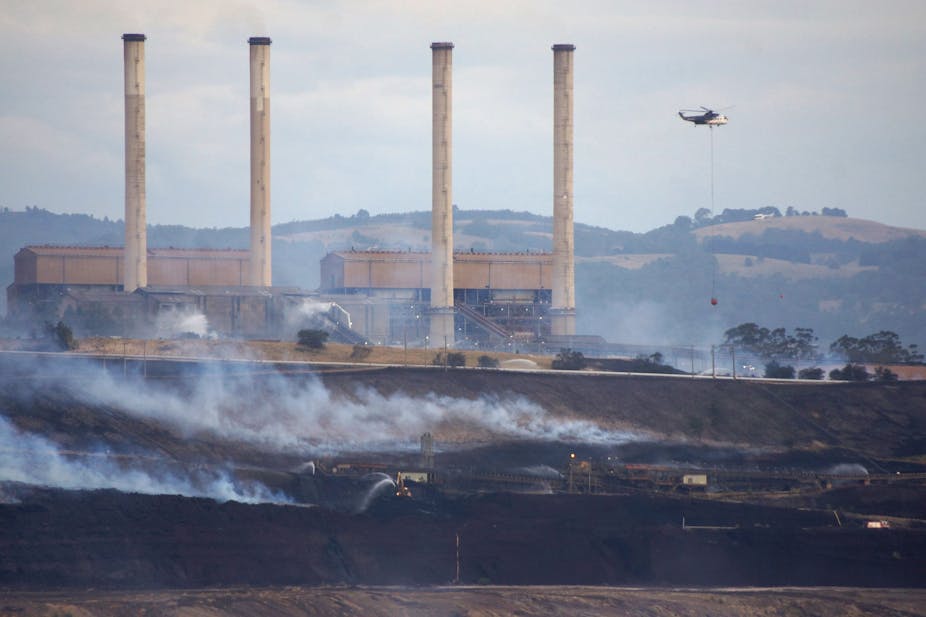The Hazelwood coal mine fire shows that Victoria’s current mining laws are not strong enough to prevent a similar disaster in the future.
While the mine’s owner GDF SUEZ has vehemently rejected claims that it failed to adequately prepare for fire and rehabilitate old parts of the mine beside the town of Morwell, the company could still be liable under Victorian law if it is found to have failed to comply with mining and environmental law.
An independent inquiry is set to get underway later this month into the month-long fire, how it started (it appears to have been sparked by a suspicious grassfire that then spread) and what has contributed to it being so bad.
The Hazelwood fire is just the latest of several in recent years at both the Hazelwood and Yallourn coal mines: so how can we prevent it happening again?
Hazelwood under Victorian law
Built by the state government in the 1960s, then privatised in 1996, Hazelwood power station generates about 20-25% of Victoria’s electricity. Now operating as GDF SUEZ Hazelwood – majority owned by global energy company GDF SUEZ, with a small stake held by Japanese company Mitsui – it includes a 1542MW power station and the adjacent 3,554 hectare brown-coal mine.
Under Victorian law (Mineral Resources Act), Hazelwood’s owners must submit a rehabilitation plan along with the work plan when they apply for a mining licence. In addition, a rehabilitation bond must be lodged, as security to ensure that the rehabilitation plan is complied with.
The amount of the rehabilitation bond is fully determined by the state resources minister. GDF SUEZ paid a A$15 million bond which, arguably, was patently inadequate given the potential cost associated with rehabilitating an open-cut mine of this size.
Significantly, the minister may require the licensee to enter into a further bond during the operation of the licence if the minister considers that the existing bond is insufficient. However, this never occurred at Hazelwood.
An assessment of the rehabilitation bond may also be undertaken if there is some doubt regarding the adequacy of the rehabilitation bond. This did not occur either.
The rehabilitation plan must take into account any special characteristics of the land, the surrounding environment, the need to stabilise the land, the desirability of returning agricultural land to a state that is as close as is reasonably possible to its state prior to the mining licence being granted and any potential long-term degradation of the environment.
A rehabilitation plan will also, generally, include progressive rehabilitation obligations given the ongoing potential for environmental degradation. It is likely that GDF SUEZ were subject to progressive rehabilitation obligations regarding the disused section of the mine. If so, the independent inquiry into the fire may end up examining if the failure to properly monitor such progressive rehabilitation obligations contributed to the risk of a coal fire.
GDF SUEZ have a 30-year mining licence, issued in 1996, which means that it comes up for renewal in 2026. That is another 12 years away and during this time, the importance of ongoing land remediation and rehabilitation, especially within disused sections of the mine, is vital.
While the minister has the power to prohibit work activities from continuing if rehabilitation obligations are breached, Victoria’s dependence on Hazelwood for electricity makes this highly unlikely. Further, given the inadequacy of the rehabilitation bond, it could end up being cheaper for GDZ SUEZ to forfeit the bond rather than undertake extensive rehabilitation processes.
GDF SUEZ could also be liable under Victoria’s Environment Protection Act. If the environment is polluted as a result of a discharge, emission or deposit of any substance from mining premises, the occupier will be deemed to have caused the pollution. The Victorian Environment Protection Authority can issue a clean up notice, either during operations or at the closure of the mine. Further, the company could still be liable even after its license expires. Under the Mineral Resources Act, GDF SUEZ can be liable up to three years from the fire, and even longer under the Environmental Protection Act.
Four ways to strengthen the law
Given the enormous health and safety risks as well as the environmental damage the coal fires can produce, the rehabilitation provisions under Victorian law aren’t sufficiently rigorous.
After a 2012 Inquiry into greenfields mineral exploration and project development in Victoria, the state government’s response focused almost exclusively on the economic barriers rehabilitation can cause for mining development. The government recommended a new start-up bond scheme reducing rehabilitation bonds by up to 50% for the first five years of mine operation.
Stronger regulation regarding the issuance of rehabilitation bonds to reduce the possibility of another disaster of this nature occurring is now urgently needed. There are four significant ways that the existing rehabilitation law can be improved.
First, the minister for resources currently has very broad discretionary power over the rehabilitation assessment process. This needs to be qualified by clear legislative criteria, to prevent potentially inadequate rehabilitation bonds being issued.
Second, there needs to be a clear legislative mandate for the ongoing assessment of the adequacy of the rehabilitation bond, particularly over long term mining licences.
Third, a minimum threshold amount for rehabilitation bonds needs to be issued. A larger bond would increase the incentive for licence holders to comply with rehabilitation obligations.
Fourth, rehabilitation obligations should be properly monitored. Mandatory monitoring obligations would significantly reduce the potential for catastrophic coal fires.
The Hazelwood fire has taken a heavy environmental and social toll, with local residents breathing in smoke, ash and toxins for weeks. How much it will cost Victorian taxpayers remains to be seen – but given the huge, ongoing firefighting and emergency response, it won’t be cheap.
Without stronger rehabilitation laws, large open-cut mines such as Hazelwood will continue to be expensive disasters waiting to happen.

